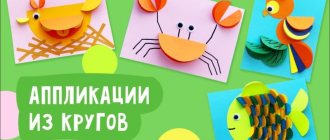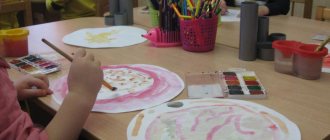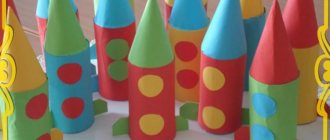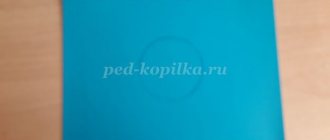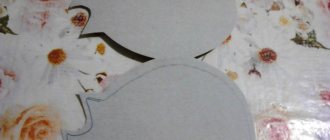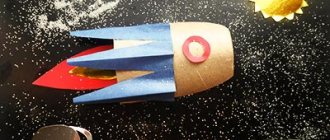MAGAZINE Preschooler.RF
Objectives: Educational: Continue acquaintance with the types and genres of fine art. Developmental: 1) Arouse interest in the search for visual and expressive means that allow you to reveal the image more accurately, fully and individually (features of appearance, character and mood of a particular person). 2) Learn to compose a portrait from separate parts (an oval - a face, strips or lumps of crumpled paper - a hairstyle). 3) Strengthen the skill of cutting out an oval from paper folded in half. 4) Develop color perception (select a color tone for the background in accordance with hair color). 5) Continue to develop the ability to evaluate your own work and the work of a friend.Educational: 1) Foster creative activity and independence, using various methods of working with paper in appliqué work. 2) Make the child want to help. 3) Develop aesthetic perception. Preliminary work: 1) Introduction to portraiture as a genre of painting. 2) Examination of reproductions of paintings by famous portrait painters. 3) Looking at photographs. 4) Drawing portraits with sticks on the ground while walking, with felt-tip pens and pencils in independent artistic activities. 5) Experimenting with different ways of working with paper in appliqué work. 6) Looking at your reflection in the mirror. 7) Drawing up verbal portraits (of yourself and the doll). Methodological techniques: reading a poem, conversation, demonstration and explanation, productive activity, theatricalization (parish of Kapitoshka). Materials: a rectangle of white paper for the oval of the face, colored paper for hairstyles and other parts of the face, a set of colored cardboard for the background of the portrait, glue, glue brushes, oilcloths, cloth napkins, samples of portraits (works of older children) for display, slides, multifunctional toy A capitoshka with a set of different shapes of lips, eyebrows and mouths, an incomplete portrait, a strip of paper with different shapes of noses, mirrors, carpet. Contents: - Guys, do you know the name of our group? - Turtles. — Yes, the name of the group hangs on our door, and everyone who comes to us will know about it (slide). — But in addition to the name, there should be a business card hanging in the locker room. What it is? — This is a corner where a photograph of all the children attending this group is pasted. For example, like in the neighboring group “Sun” (slide). — I went to the photographer, but he is busy and cannot come to photograph you. What should we do? — You can draw yourself, make an applique, or bring a finished photograph from home. - Thank you for telling me how to get out of this situation. This means that each of you will have to take your own portrait. Let me remind you what it is. If you see that someone is looking at us from a painting - a pilot or a ballerina, or Kolka is your neighbor - the painting is definitely called a portrait. - Please note that the portrait should be such that anyone looking at it can recognize who is depicted in it. — I made the corner where your works will be placed. Here he is. What does it look like? - For a turtle. — Everything you need to do the work is on your tables. The background for the portrait will be colored cardboard. First, let’s clarify which background to choose correctly? You have light and dark colored cardboard on your tables. If you are fair-haired, what color cardboard do you choose? - Dark. - If dark-haired - light-haired. - Why are we doing this? — To make the hair more visible, the work turned out to be brighter. — I brought you several samples of portraits made by children of the senior group. The details of their faces are drawn, but you are children of the preparatory group and therefore you will make them out of paper. — Make an oval face from a rectangle. Fold it in half, hold it by the fold line and round the corners. “I’ll tell you guys that to quickly glue the oval to the background, glue should not be spread on the entire oval, but only on the edge, and stick it on the cardboard so that there is room on top for the hairstyle.” - Let's move on to the hair. A) Straight hair can be made from strips of paper. B) By cutting out wavy lines, we will get wavy hair or braids, they can be made by tearing strips from a large sheet of colored paper. C) You can make hair using a mosaic method - this is when small pieces of paper are torn off and glued on. D) You can get curly hair by crumpling pieces of paper. D) If the hair is curly, it can be made from serpentine, obtained by pulling a straight strip pressed to the edge of the scissors. — This is how we made an autumn birch tree (slide). (During the explanation I show examples from the samples).
- When the hair is ready, you can start shaping the hairstyle. It could be ponytails, braids or something else. Everyone knows their hairstyle. -What do we all have on our faces? - Two eyes, two eyebrows, nose, mouth. — Eyes are cut out circles that lie on your tables. Everyone glues a circle exactly the same color as your eyes. — For eyebrows, paper is black and brown. Eyebrows can be of different shapes: triangular, rectangular or arched (shown from the set for Kapitoshka). — We make the mouth out of what color paper? - Red. — It can also be different (show from the set for Kapitoshka). - From all these details you can get different facial expressions: sad, smiling, surprised, scared. I don’t know what yours will be like. — The nose can be like this (showing a tape with samples of noses of different shapes). — We make ears from semi-ovals or semicircles. — You can draw on some things with felt-tip pens. Like what? - Eyelashes, freckles, earrings. - Does everyone understand how to do what? — You can go to the mirror to look at yourself and get to work. “I would like to remind you of the proverb: “If you hurry, you make people laugh.” This means that before you start doing something, you need to think about how and what you will do. (Children complete the task. We hang the finished work on a business card - a turtle, remove the workspaces). - Oh, what beautiful and different portraits you turned out! What is a kindergarten? This is a home for all the guys. This is joy, this is laughter, This is a hundred friends for everyone.
If we become alike, how can we recognize each other?
You're not like others, that's why you're good for mom!
The only thing dearer to her is Andryushka’s freckled freckles, Tanya’s protruding ears and snub nose.
All shapes and colors of your hair and eyes. Dear children, very different, the best and most beautiful!
- Well done boys! Thank you for helping us design our group’s business card.
Children's work for the lesson “My Portrait”
| Next > |

